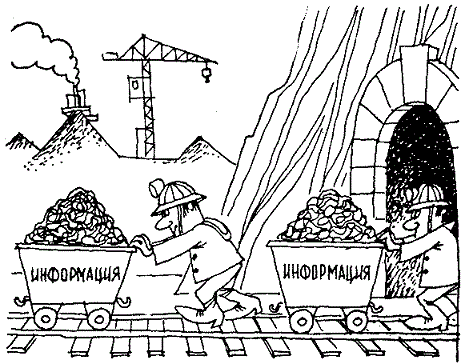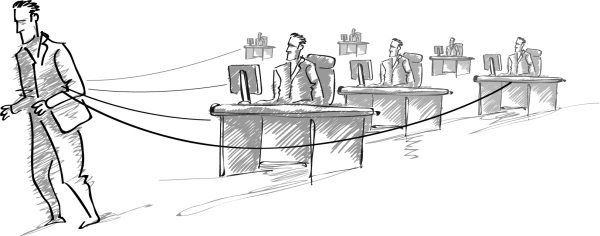Corporate Utopia Communication Environment
 The work of any large company creates a daily flow of information in hundreds, even if not thousands of gigabytes of information, and often for the most part repetitive among themselves. We keep quotes of a good hundred answers in correspondence, including furious signatures with a sidebar on confidentiality of information. We store a dozen versions of the same documents arranging a file bin from the “knowledge base”. The culture of information storage and data exchange is akin to the everyday culture of society. However, if the best of us still taught not to litter on the street, then very few of the best have independently learned a highly material culture. Yes, yes, it was precisely learned, there was nobody to teach us, who were born in an embrace with a computer.
The work of any large company creates a daily flow of information in hundreds, even if not thousands of gigabytes of information, and often for the most part repetitive among themselves. We keep quotes of a good hundred answers in correspondence, including furious signatures with a sidebar on confidentiality of information. We store a dozen versions of the same documents arranging a file bin from the “knowledge base”. The culture of information storage and data exchange is akin to the everyday culture of society. However, if the best of us still taught not to litter on the street, then very few of the best have independently learned a highly material culture. Yes, yes, it was precisely learned, there was nobody to teach us, who were born in an embrace with a computer.And so, back to the corporation, today we will discuss the work of a spherical employee of a large corporation, where ISO 9000, PMO, CMMI, and in general all products are developed and implemented very cool .
Once a step
Point one: “our favorite spherical employee,Once, when my one friend saw the screen of my mailbox, he asked me a question that put me in a stupor: "Why are you transferring letters from INCOMING to other folders?". I did not even know what to say to him. This was my habit, and I no longer understood how to live with a clogged inbox? After all, e-mail is no different from paper. How do you imagine the left letter in the mailbox near the house? I can not imagine. I hope you too. Each letter should be in its folder. You do not interfere with rice with buckwheat, why do it with letters?How to teach spherical employees? Read a lecture about GTD, present a couple of books, send to watch and listen to Dorofeev . Hold a master class, show the benefits, convenience, tell us about the philosophy of life. Create a platform for culture, it needs to come somewhere. She is wearing heels and wearing a red dress. Start with the most important, with the basics.
Two steps
A step forward and one more step of maturity, point two: “our employee transfers documents to a network drive”. Now he will have to face the need to store versions of documents, the impossibility of collaboration, the lack of a full search for the content of documents. Although, to be honest, this is not necessary. Practice shows that many, in spite of existing network drives, do not, preferring to keep and carefully protect their own belongings. "Rejection and creation of knowledge of the company?", - no, I did not hear!
')
Well, if the platform is already there, you need to lay the rails and start the trolleys. To force to store the documentation on network drives it is possible. Here you need a process and a hard decision, determine the rules for saving the result of work (in a network folder).
One day I was faced with the task of storing and managing project documentation as an RP. I tried various methods, approaches, endless conversations with employees, but they did not work. I had to store all the mail myself. Accordingly, except for me, no one needed it. The solution was found simple - the condition was set in the original task, the document should lie in a specific project folder, otherwise the task was considered incomplete (of course, except for cases when a person does not have access to this folder). For a short period, the team learned to live by these rules, and subsequently they took root in the culture.
Three steps?
Network drives are the first step to a big way. However, we have said earlier, there are certain technical problems in the form of: the lack of storage of versioned documents, collaborative (simultaneous) work, contextual search, and other functions that make life more pleasant. Network drives - this is, in fact, already the last century, you know? Experience shows that, up to a certain point, the notorious spherical employees of a large corporation somehow manage without these functions. The mail exchange document culture has taken root so deeply that it is difficult to unlearn from it, by any means. In this case, the level of maturity can freeze at this level for five years. The second factor, similar to “freezing” - the existing technologies at the moment, still do not fully support the functions of full-fledged “live” co-editing.
Experience shows that, up to a certain point, the notorious spherical employees of a large corporation somehow manage without these functions. The mail exchange document culture has taken root so deeply that it is difficult to unlearn from it, by any means. In this case, the level of maturity can freeze at this level for five years. The second factor, similar to “freezing” - the existing technologies at the moment, still do not fully support the functions of full-fledged “live” co-editing.Despite the emergence of many services, such as Google Docs, EverNote, and others , unfortunately, they are not fully managed applications in a private cloud for a corporation with a full AD (Active Directory). Embedding such services in a corporate environment is often impossible. The lack of a general IT development strategy in a company and / or an information vacuum for spherical employees in various departments leads to problems of closure, decentralization of IT functions, and keeping records in the clouds without complying with corporate rules. The answer to the question of how to provide employees with useful services should be decided jointly by the IT department and structural divisions.

Despite all the desires and conversations of the expert council at the department, it was a dead weight. However, the “driver” did not have to wait long, at some point it became the task of writing a complex and large document for several people. Moreover, the document had to be edited in parallel in completely different sections, while maintaining the integrity and logic of the structure. The young and ambitious employee did not want to break the document into parts, shout “remove my green discharge” to the whole office, “urgently leave the document”, he was tired and he got down to business. ... SkyDrive was just a godsend, he supported co-editing Word through both the web-app, and with the help of the “fat client” MS Word 2010/2013. Subsequent monthly work with one document showed that the system works perfectly. Employees could do almost everything: simultaneously edit a document, comment, move sections, its versioning is automatically stored. The only drawback of the “fat client” was the need to permanently save the document, pressing CTRL + S every 10 minutes, at first it was difficult for some. It would seem - here it is happiness! ...
What about our spherical employees? And they, together with the IT department, raised SharePoint Server with all the advantages of synchronized AD, and the capabilities of a fully-featured, customizable portal. The last step in front of the stairs: “employees jointly edit, store and manage documentation in the context of project activities”.
Here, the entire work of the project team of spherical employees begins with the creation of a repository for project documents. The manager is no longer loaded with questions about where to get the necessary information. Content management already has its beginning, to which other employees will be able to refer to the results of the project.
There will be a ladder
Despite the fact that currently our favorite spherical employee uses only a small part of the portal's capabilities, but now he knows and knows how to manage the documentation. He is sure that the documents will not disappear anywhere. They can not be accidentally moved to the next folder, deleted or simply lost. He knows that by pressing the save button, the previous version of the document is always available through the File menu in MS Office. He can find any document in an ever conducted project on its content.
Tomorrow he will want more: a project calendar, internal discussions, setting tasks, setting tags and likes to documents, forming a unit of knowledge base.

Building a ladder, this is the development ahead - this is a look into the future. Social functions in an organization are just as important as team communication. Providing storage and management of project documentation, it is possible to go to a full-fledged knowledge base. Perhaps it will be an ideal social network to ensure convenient work of the project team. You have a design organization, aren't you?
Source: https://habr.com/ru/post/187080/
All Articles